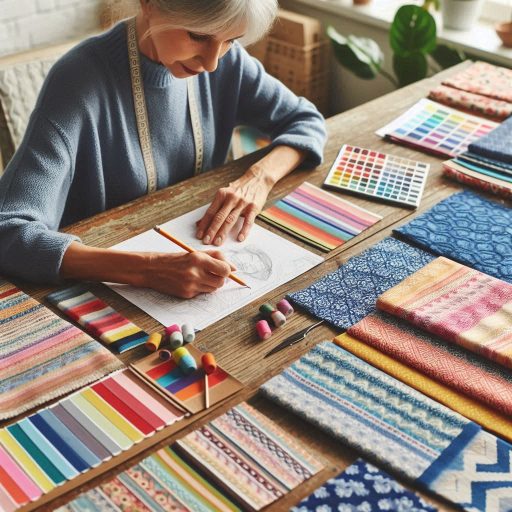Introduction
In the world of textile design, a portfolio serves as a visual resume, showcasing a designer’s creativity, skills, and unique style.
It is a curated collection of a designer’s best work, illustrating their journey, design philosophy, and technical abilities.
A well-structured portfolio is not just a collection of images; it tells a story about the designer’s artistic vision and thought process.
Having a strong portfolio is crucial in the competitive field of textile design.
As the industry grows and evolves, the demand for innovative and distinctive designs increases.
A compelling portfolio sets designers apart, attracting the attention of potential clients and employers.
It serves as a powerful marketing tool that highlights your strengths and versatility, making it easier to secure opportunities in a crowded marketplace.
Moreover, a strong portfolio demonstrates your ability to adapt to different styles and trends, showcasing your breadth of knowledge in textiles.
It instills confidence in clients and employers, reassuring them that you can meet their design needs effectively.
In a field where creativity is key, investing time and effort into developing an exceptional portfolio is essential for any aspiring textile designer.
Understand the Industry
Building a strong portfolio as a textile designer begins with understanding the industry landscape.
Familiarize yourself with the various sectors within textile design.
These sectors include fashion, interiors, and technical textiles.
Each area has unique requirements and styles.
Understanding these nuances helps tailor your portfolio effectively.
Research Current Trends and Styles in Textile Design
Researching current trends is crucial for any textile designer.
Stay updated with industry publications and online resources.
Follow blogs and social media channels dedicated to textile design.
Platforms like Pinterest and Instagram showcase emerging trends.
Analyze how different designers interpret these trends in their work.
Pay attention to the color palettes, textures, and patterns gaining popularity.
Understanding these trends will help you create relevant and appealing designs.
Identify Key Players in the Industry and Study Their Portfolios for Inspiration
Next, identify the key players in the textile design industry.
These may include established designers, brands, and manufacturers.
Studying their portfolios offers valuable insights into successful design strategies.
Make a list of influential designers you admire.
Explore their career trajectories and how they built their portfolios.
Look for common themes and styles in their work.
Consider how you can incorporate elements of their success into your portfolio.
This does not mean copying their work but rather drawing inspiration.
Attend industry events, trade shows, and exhibitions.
These gatherings allow you to network with professionals and gain insights.
Meeting industry leaders can open doors for collaboration and mentorship.
Use these opportunities to ask questions and learn from their experiences.
Creating a mood board can help visualize your design concepts.
Compile images, fabrics, and color palettes that resonate with you.
This board can guide your design process and serve as a foundation for your portfolio.
Regularly update it as you discover new inspirations.
Consider enrolling in textile design courses or workshops.
These can enhance your skills and provide networking opportunities.
Learning from experienced professionals will also help you understand industry expectations.
Seek feedback from peers and mentors to refine your work.
Building a diverse portfolio showcases your versatility.
Include various textile designs, such as prints, weaves, and embroideries.
Highlight different techniques, styles, and concepts to appeal to a broader audience.
Ensure that each piece reflects your unique voice as a designer.
Finally, remember that a strong portfolio is a living document.
Regularly update it with new projects and trends.
Reflect on your growth as a designer and adapt your work accordingly.
By understanding the industry and staying informed, you’ll create a compelling portfolio that stands out.
Showcase Your Best Work
A strong portfolio as a textile designer hinges on showcasing your best work.
The pieces you include should reflect your creativity and technical skills.
Quality over quantity is essential; a few standout pieces often make a more significant impact than many mediocre ones.
Select a Variety of Your Strongest Pieces to Include in Your Portfolio
Choose a diverse range of designs to exhibit your strengths.
Include various types of textile designs, such as prints, weaves, and embroidery.
This variety demonstrates your ability to work across different techniques and styles.
Consider the different markets you wish to target, such as fashion, interiors, or functional textiles.
Tailor your selections to appeal to those specific audiences.
When selecting pieces, think about how each one highlights your unique voice as a designer.
Look for designs that received positive feedback or garnered attention in previous projects.
These pieces will not only show your skills but also your potential for future work.
Additionally, ensure that the designs you choose are cohesive, creating a unified narrative in your portfolio.
Include Projects That Demonstrate Your Skills and Versatility as a Textile Designer
Highlight projects that best showcase your versatility and skill set.
For example, include a project that demonstrates your ability to create complex patterns.
You might also want to feature a project that showcases your knowledge of sustainable materials.
This approach will appeal to a broader audience and emphasize your adaptability in the industry.
Don’t hesitate to include collaborative projects or internships.
These experiences often provide unique insights and valuable skills.
They also demonstrate your ability to work in team environments, which is essential in the design industry.
Describe your role in these projects clearly, focusing on what you contributed.
Visual presentation is crucial when showcasing your work.
Use high-quality images that capture the texture and color of your textiles accurately.
Consider including close-ups to highlight intricate details.
A clean and professional layout enhances the overall appeal of your portfolio.
Make sure to organize your work logically, guiding viewers through your creative journey.
Lastly, accompany each piece with a brief description.
Explain the concept behind the design, the techniques used, and the materials chosen.
This context adds depth to your portfolio, allowing viewers to appreciate your thought process and design philosophy.
By carefully selecting and presenting your best work, you can create a portfolio that not only showcases your talent but also tells your unique story as a textile designer.
Read: Building a Portfolio for Costume Design
Include Process Work
Including process work in your portfolio is essential for illustrating your creative journey as a textile designer.
This element allows potential clients and employers to see not only the final product but also the thinking and effort behind it.
Showcasing your process can differentiate you from other designers, highlighting your unique approach to design.
Show Sketches, Mood Boards, and Swatches to Demonstrate Your Creative Process
Start by incorporating sketches that capture your initial ideas.
These sketches can range from rough doodles to detailed drawings.
They provide insight into your brainstorming phase and how you visualize concepts.
Displaying a progression from initial sketches to final designs shows your ability to refine and develop ideas over time.
Next, include mood boards that reflect your inspiration and design direction.
A mood board can encompass colors, textures, images, and patterns that resonate with your design theme.
This visual compilation helps viewers understand the context of your work.
It also highlights your ability to curate and synthesize various elements into a cohesive concept.
Swatches are another valuable addition to your portfolio.
Including fabric swatches allows viewers to see and feel the materials you work with.
This tactile element can be particularly impactful in textile design.
Swatches demonstrate your knowledge of textiles and your ability to select materials that complement your designs.
Insight into How You Approach Design Challenges and Problem-Solving
To further illustrate your creative process, provide insights into how you tackle design challenges.
Describe specific obstacles you’ve faced and the strategies you employed to overcome them.
This could involve technical difficulties, client feedback, or material limitations.
Showing your problem-solving skills demonstrates resilience and adaptability—qualities that are highly valued in the industry.
Consider including case studies or brief narratives alongside your process work.
These stories can provide context for your sketches, mood boards, and swatches.
Explain how a particular project evolved, including any iterations and changes along the way.
This narrative approach adds depth to your portfolio and helps viewers connect with your work on a personal level.
Be sure to present this process work in a visually appealing manner.
Organize it logically, so viewers can easily follow your design journey.
Use high-quality images and a clean layout to maintain a professional appearance.
The combination of finished designs and process work creates a well-rounded portfolio that showcases your skills, creativity, and problem-solving abilities.
Incorporating process work not only enriches your portfolio but also reflects your commitment to thoughtful design.
It allows potential clients and employers to appreciate the full scope of your abilities as a textile designer.
By sharing your creative journey, you invite others into your world, making your portfolio more engaging and impactful.
Read: Famous Costume Designers in Hollywood
Highlight Your Skills
Highlighting your skills is a crucial part of building a strong portfolio as a textile designer.
This section allows you to showcase your technical abilities and unique talents, setting you apart from other designers.
Clearly outlining your skills helps potential clients and employers understand what you bring to the table.
Technical Skills Such as Pattern-Making, Digital Design Software Proficiency, and Knowledge of Fabric Types
Begin by listing your technical skills, starting with pattern-making.
This foundational skill is essential for creating intricate designs and ensuring proper fit.
Discuss your experience with different pattern-making techniques, such as draping or flat pattern drafting.
Next, emphasize your proficiency in digital design software.
Highlight programs such as Adobe Illustrator, Photoshop, and textile-specific software like NedGraphics or CAD software.
Mention any relevant certifications or courses that enhance your qualifications in these tools.
Proficiency in digital design software is essential for modern textile designers, as it allows for efficient and precise creation of designs.
Knowledge of various fabric types is another critical skill.
Discuss your familiarity with different textiles, including natural fibers, synthetics, and blends.
Understanding the properties of each fabric enables you to make informed decisions about material selection.
This knowledge enhances the quality and functionality of your designs.
Specialized Skills or Techniques That Set You Apart from Other Textile Designers
In addition to technical skills, include any specialized techniques that distinguish you from other textile designers.
This could involve unique printing methods, sustainable practices, or innovative dyeing techniques.
If you have experience with hand-drawn prints, digital fabric printing, or weaving, make sure to highlight these talents.
Specialized skills may also include knowledge of sustainable and eco-friendly practices.
If you incorporate sustainable materials or processes in your designs, emphasize this commitment.
More clients are seeking environmentally conscious designers, so showcasing this expertise can give you a competitive edge.
Additionally, consider mentioning any awards, publications, or exhibitions that feature your work.
These accolades provide credibility and demonstrate recognition of your skills.
They also highlight your active engagement with the design community.
Present your skills in a clear and organized manner.
Use bullet points or a dedicated section in your portfolio to list these abilities.
This structured approach makes it easy for viewers to quickly grasp your qualifications.
By highlighting your skills effectively, you demonstrate your expertise and unique qualities as a textile designer.
This emphasis on your abilities not only enhances your portfolio but also positions you as a strong candidate in the competitive field of textile design.
Potential clients and employers will appreciate the clarity and focus, making your portfolio more impactful.
Read: Essential Skills for Aspiring Costume Designers

Get Feedback
Getting feedback is a crucial step in building a strong portfolio as a textile designer.
Sharing your work with others can provide valuable insights and constructive criticism.
This feedback is essential for refining your portfolio and ensuring it effectively showcases your skills and creativity.
Share Your Portfolio with Mentors, Colleagues, or Industry Professionals for Constructive Criticism
Start by sharing your portfolio with mentors or experienced colleagues in the textile design field.
They can offer an outsider’s perspective, pointing out strengths and weaknesses you might overlook.
Mentors, in particular, can provide guidance based on their own experiences, helping you navigate common pitfalls.
Consider also reaching out to industry professionals.
This could include designers whose work you admire or contacts you’ve made at networking events.
Engaging with professionals can yield diverse viewpoints and innovative suggestions.
Their feedback may highlight industry trends and expectations that you might not have considered.
When sharing your portfolio, be specific about the type of feedback you’re seeking.
You might ask for opinions on your design choices, the clarity of your presentation, or overall cohesiveness.
This focused approach can help reviewers provide more meaningful critiques.
Use Feedback to Refine and Improve Your Portfolio Before Presenting It to Potential Clients or Employers
Once you gather feedback, take the time to analyze it thoroughly.
Look for common themes in the critiques to identify areas for improvement.
Constructive criticism can help you see your work from different angles, encouraging you to refine your designs and presentation.
Incorporate the feedback into your portfolio thoughtfully.
Make necessary adjustments to enhance clarity, visual appeal, and overall organization.
This process may involve reselecting pieces, improving descriptions, or adjusting layouts to better align with industry standards.
Don’t hesitate to seek additional feedback after making revisions.
Sharing the updated version with your mentors or colleagues can provide further validation.
This iterative process ensures that your portfolio evolves and improves based on external input.
Lastly, remember that feedback is a tool for growth, not a judgment of your talent.
Embrace constructive criticism with an open mind, viewing it as an opportunity to elevate your work.
By refining your portfolio based on insightful feedback, you’ll present a polished and professional representation of your skills to potential clients or employers.
In summary, gathering feedback is a vital part of creating a compelling textile design portfolio.
By actively seeking input and using it to improve your work, you can enhance the quality and effectiveness of your portfolio.
This proactive approach will ultimately increase your chances of success in the competitive textile design industry.
Read: Visual Merchandiser: Job Market and Opportunities
Transform Your Career Today
Unlock a personalized career strategy that drives real results. Get tailored advice and a roadmap designed just for you.
Start NowKeep It Updated
Keeping your portfolio updated is essential for showcasing your growth as a textile designer.
An updated portfolio reflects your current skills, trends, and experiences, making it more appealing to potential clients and employers.
Regular updates ensure that your work stays relevant and accurately represents your design journey.
Regularly Update Your Portfolio with New Projects and Experiences
Make it a habit to update your portfolio regularly, especially after completing new projects or gaining new experiences.
As you develop new skills and techniques, ensure that your portfolio reflects this growth.
Adding recent work demonstrates your ongoing commitment to the craft and your adaptability in a constantly evolving industry.
Consider scheduling quarterly or biannual reviews of your portfolio.
During these reviews, evaluate your recent projects and identify those that showcase your best work.
Highlight pieces that represent significant milestones or breakthroughs in your design process.
Including a diverse range of projects can also illustrate your versatility and ability to cater to different markets.
Additionally, document any workshops, courses, or certifications you complete.
These experiences can enrich your portfolio, showcasing your dedication to continuous learning.
They also highlight your willingness to evolve and stay current in the textile design field.
Remove Outdated or Weaker Pieces to Maintain a Cohesive and Impactful Presentation
While it’s important to add new work, equally important is the removal of outdated or weaker pieces.
Regularly assess your portfolio to identify any designs that no longer represent your current skill level or style.
Removing these pieces helps maintain a high standard, ensuring that your portfolio is cohesive and impactful.
Evaluate each piece for its relevance and quality.
If a project no longer resonates with your design aesthetic or has been surpassed by your more recent work, consider removing it.
A streamlined portfolio with only your best work creates a stronger impression and keeps the focus on your most compelling designs.
Maintaining a cohesive presentation is vital for creating a professional portfolio.
Organize your work logically, grouping similar projects together to illustrate your design evolution.
A well-structured portfolio enhances the viewer’s experience, making it easier to navigate and understand your journey as a designer.
Lastly, consider seeking feedback after making updates.
Sharing your revised portfolio with mentors or colleagues can provide fresh perspectives.
They can help you ensure that your selection of pieces presents a strong narrative and aligns with current industry trends.
Regularly updating your portfolio is key to showcasing your growth and relevance as a textile designer.
By adding new projects and experiences while removing outdated work, you can create a cohesive and impactful presentation.
This ongoing maintenance will not only enhance your portfolio but also strengthen your position in the competitive textile design market.
Conclusion
Building a strong portfolio is essential for textile designers seeking to make their mark in the industry.
A well-crafted portfolio showcases your skills, creativity, and unique design perspective to potential clients and employers.
Start by curating a diverse selection of your best work that reflects your design style and versatility.
Include various projects that highlight different techniques, materials, and styles, demonstrating your adaptability.
Make sure to display your design process, from initial sketches to finished products.
This approach provides insight into your thought process and problem-solving abilities.
Consider adding fabric swatches or samples to give a tactile experience, allowing viewers to engage with your work on a deeper level.
An engaging portfolio tells a story about your design journey, capturing the evolution of your style and technique.
Tailor your portfolio to target specific job opportunities or clients.
Research the preferences of your audience and customize your selections accordingly.
Keep your portfolio updated with your latest projects, achievements, and any new skills you acquire.
Regularly revisiting and refreshing your work is crucial as the industry evolves.
Remember that your portfolio is a reflection of your unique talent and personality.
Don’t hesitate to show who you are as a designer.
Use thoughtful layouts and compelling visuals to create a cohesive narrative.
Start working on your portfolio today to make a lasting impression in the textile industry.
Your creativity deserves to be showcased, and a strong portfolio will open doors to new opportunities.
Embrace the process, and let your passion for textile design shine through!




